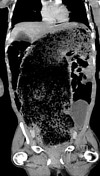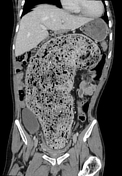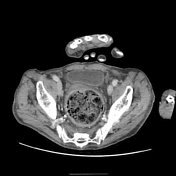Fecal impaction
Updates to Article Attributes
Faecal loading, also called faecal impaction, refers is the inability to the accumulation ofspontaneously evacuate solid faeces. It is common in the rectum and the large bowelelderly population. A severe form of faecal impaction is often referred to as a faecaloma.
Epidemiology
Faecal loadingimpaction is common, and usually seen among the elderly, bedridden patients or incapacitated people, but many risk1,2.
Risk factors are recognised including
- chronic or severe constipation
, - sedentary lifestyle
, - low
fiberfibre diet, -
certain medication
intake, e.g. opioids.1,2 - history of faecal impaction 3
Clinical presentation
Patients may complaint from :
abdominal tendernessmeteorismproctalgia-
infrequent defecationcomplain ofsolid stool
Pathology
Faecal impaction is most commonly a complication of chronic or severe constipation where inspissated hard faeces accumulates in the distal gastrointestinal tract, most commonly the rectum 3. Other causes include anatomical causes (e.g. megarectum, anorectal stenosis, malignancy) or functional causes (e.g. pelvic floor dysfunction) 3.
Radiographic features
Plain radiographsradiograph
Faecal loadingimpaction may be seen as a speckled low density-density soft tissue mass, within a distended large bowel.
US
Distension of, most commonly the small bowel loops may be observedrectum 1,2.
Complications
Untreated faecal loading may lead to an increase in large bowel pressure with possible bowel obstruction or , stercoral colitis and/or stercoral perforation.
It may also exert pressure on adjacent organs and vessels with a reported case of bilateral pelvic venous thrombosis 21,2.
Treatment and prognosis
Faecal loadingImpacted faecal removal may be performed manually, with water irrigation, enema, laxatives or with rectal cleansing under sigmoidoscopy1,2.
Physical activity, fiberfibre-rich diet, sufficient fluid intake and prokinetic drugs are prescribed to stimulate transit and to change the stool consistency, thus preventing recurrence1,2.
-<p><strong>Faecal loading,</strong> also called <strong>faecal impaction</strong>, refers to the accumulation of solid faeces in the rectum and the large bowel.</p><h4>Epidemiology</h4><p>Faecal loading is common, and usually seen among elderly, bedridden patients or incapacitated people, but many risk factors are recognised including chronic constipation, sedentary lifestyle, low fiber diet, medication intake, e.g. opioids.</p><h4>Clinical presentation</h4><p>Patients may complaint from :</p><ul>-<li>abdominal tenderness</li>-<li>meteorism</li>-<li>proctalgia</li>-<li>infrequent defecation of solid stool</li>-</ul><h4>Radiographic features</h4><h5>Plain radiographs</h5><p>Faecal loading may be seen as a speckled low density soft tissue mass, within a distended large bowel.</p><h5>US</h5><p>Distension of the small bowel loops may be observed.</p><h4>Complications</h4><p>Untreated faecal loading may lead to an increase in large bowel pressure with possible bowel obstruction or stercoral perforation.</p><p>It may also exert pressure on adjacent organs and vessels with a reported case of bilateral pelvic venous thrombosis <sup>2</sup>.</p><h4>Treatment</h4><p>Faecal loading removal may be performed manually, with water irrigation, enema, laxatives or with rectal cleansing under sigmoidoscopy.</p><p>Physical activity, fiber-rich diet, sufficient fluid intake and prokinetic drugs are prescribed to stimulate transit and to change the stool consistency, thus preventing recurrence.</p>- +<p><strong>Faecal impaction</strong> is the inability to spontaneously evacuate solid faeces. It is common in the elderly population. A severe form of faecal impaction is often referred to as a <a title="Faecaloma" href="/articles/faecaloma">faecaloma</a>. </p><h4>Epidemiology</h4><p>Faecal impaction is common and usually seen among the elderly, bedridden patients or incapacitated people <sup>1,2</sup>.</p><h5>Risk factors</h5><ul>
- +<li>chronic or severe constipation</li>
- +<li>sedentary lifestyle</li>
- +<li>low fibre diet</li>
- +<li>certain medication, e.g. opioids <sup>1,2</sup>
- +</li>
- +<li>history of faecal impaction <sup>3</sup>
- +</li>
- +</ul><h4>Clinical presentation</h4><p>Patients may complain of constipation, rectal discomfort, abdominal pain, tenderness or distension <sup>1-3</sup>.</p><h4>Pathology</h4><p>Faecal impaction is most commonly a complication of chronic or severe constipation where inspissated hard faeces accumulates in the distal gastrointestinal tract, most commonly the rectum <sup>3</sup>. Other causes include anatomical causes (e.g. megarectum, anorectal stenosis, malignancy) or functional causes (e.g. pelvic floor dysfunction) <sup>3</sup>. </p><h4>Radiographic features</h4><h5>Plain radiograph</h5><p>Faecal impaction may be seen as a speckled low-density soft tissue mass within a distended large bowel, most commonly the rectum <sup>1,2</sup>. </p><h4>Complications</h4><p>Untreated faecal loading may lead to an increase in large bowel pressure with possible <a href="/articles/bowel-obstruction">bowel obstruction</a>, <a href="/articles/stercoral-colitis">stercoral colitis</a> and/or <a href="/articles/stercoral-perforation">stercoral perforation</a> <sup>1,2</sup>.</p><h4>Treatment and prognosis</h4><p>Impacted faecal removal may be performed manually, with water irrigation, enema, laxatives or with rectal cleansing under sigmoidoscopy <sup>1,2</sup>.</p><p>Physical activity, fibre-rich diet, sufficient fluid intake and prokinetic drugs are prescribed to stimulate transit and to change the stool consistency, thus preventing recurrence <sup>1,2</sup>.</p>
References changed:
- 3. Obokhare I. Fecal Impaction: A Cause for Concern? Clin Colon Rectal Surg. 2012;25(1):53-8. <a href="https://doi.org/10.1055/s-0032-1301760">doi:10.1055/s-0032-1301760</a> - <a href="https://www.ncbi.nlm.nih.gov/pubmed/23449376">Pubmed</a>
Sections changed:
Image ( destroy )
Image ( destroy )
Image ( destroy )
Image ( destroy )
Image ( destroy )
Image 1 X-ray (Frontal) ( create )

Image 2 CT (C+ portal venous phase) ( create )

Image 3 CT (C+ portal venous phase) ( create )

Image 4 CT (C+ portal venous phase) ( create )








 Unable to process the form. Check for errors and try again.
Unable to process the form. Check for errors and try again.